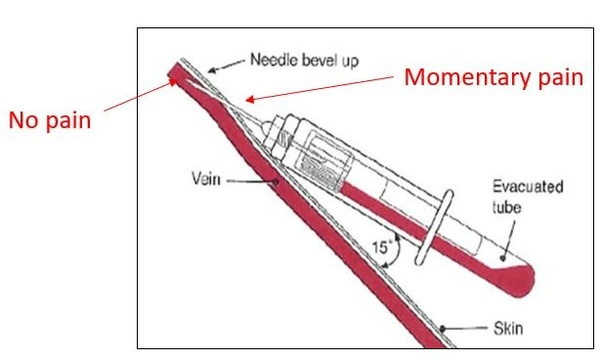Which of the following locations should a phlebotomist use to anchor a vein during a venipuncture using the evacuated tube method?
1 to 2 inches below the puncture site
1 to 2 inches above the puncture site
2 inches left of the puncture site
1 inch right of the puncture site
The Correct Answer is A
Choice A Reason:
Anchoring a vein is a technique used to stabilize the vein during venipuncture to prevent it from rolling. The recommended practice is to anchor the vein 1 to 2 inches below the puncture site. This is done by applying gentle traction on the skin downward with the thumb, which helps to stabilize the vein and facilitate the insertion of the needle.
Choice B Reason:
Anchoring 1 to 2 inches above the puncture site is not the standard practice. This position would not provide the necessary tension on the vein to prevent it from rolling and could make the venipuncture more difficult.
Choice C Reason:
Anchoring 2 inches left of the puncture site does not provide the correct angle or tension for stabilizing the vein for a venipuncture and is not a recommended technique.
Choice D Reason:
Anchoring 1 inch right of the puncture site is also not a recommended practice. Similar to anchoring to the left, this does not provide the proper stabilization needed for a successful venipuncture.

Nursing Test Bank
Naxlex Comprehensive Predictor Exams
Related Questions
Correct Answer is B
Explanation
Choice A reason:
Using a needle at a 45° angle does not typically result in collapsing the vein. A collapsed vein is more likely due to excessive vacuum pressure from the tube, a very small or fragile vein, or the tourniquet being too tight.
Choice B reason:
At a 45° angle, the needle is more likely to penetrate through the entire depth of the vein, especially if the vein is superficial. This can result in a failed venipuncture because the needle has entered and exited the vein, missing the opportunity to collect blood.
Choice C reason:
While a steep angle like 45° could cause the needle to miss the vein superficially, it is more likely that the needle would go through the vein at this angle rather than merely missing it superficially. A superficial miss is more likely with an angle that is too shallow.
Choice D reason:
Contacting the upper wall of the vein alone would not necessarily result in a failed venipuncture. However, at a 45° angle, the needle could easily slip through the vein entirely after contacting the upper wall, especially if the vein is not anchored well.
Correct Answer is C
Explanation
Choice A Reason:
A multipart requisition involves multiple copies of a paper form, which can be prone to errors due to manual entry, misplacement, or illegible handwriting. While it provides physical copies for various departments, it is not the most accurate method compared to digital solutions.
Choice B Reason:
A manual requisition is similar to a multipart requisition but typically consists of a single form. It carries the same risks of human error and does not offer the benefits of automated tracking and data entry that come with electronic systems.
Choice C Reason:
An automated requisition is considered the most accurate method for receiving orders for specimen collection. It reduces the risk of human error associated with manual data entry and allows for better tracking and integration with laboratory information systems. Automated systems can also provide immediate feedback if there is an issue with the order, such as a missing patient identifier or a test code.
Choice D Reason:
A verbal requisition is the least reliable method as it depends on the memory and communication skills of the individuals involved. It lacks the documentation and verification steps present in written or automated methods, making it susceptible to misunderstandings and errors.
Whether you are a student looking to ace your exams or a practicing nurse seeking to enhance your expertise , our nursing education contents will empower you with the confidence and competence to make a difference in the lives of patients and become a respected leader in the healthcare field.
Visit Naxlex, invest in your future and unlock endless possibilities with our unparalleled nursing education contents today
Report Wrong Answer on the Current Question
Do you disagree with the answer? If yes, what is your expected answer? Explain.
Kindly be descriptive with the issue you are facing.
